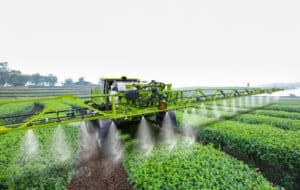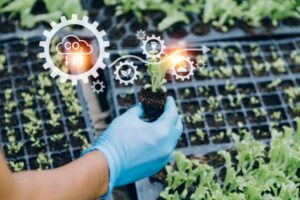Regenerative Agriculture: Restoring Soil Health for a Sustainable Future
Introduction
Regenerative agriculture is a holistic approach for farmers because it is an evolution of conventional farming which focuses on soil health, promoting diversity, and mitigating climate change.
It helps reduce water use and prevent land degradation and deforestation.
Healthy soil is an important element for a sustainable future.
It helps farmers in many ways crop yielding, reducing the need for fertilizers and pesticides, providing nutrients to crops, regulating water runoff, improving air quality, providing an ideal environment for root development, and reducing the effects of climate change.

The Degradation of Soil Health
Soil degradation is a serious environmental problem that human activities and other natural processes can cause.
It includes the loss of organic matter and a decline in soil fertility.
It can be through various processes including deforestation, soil erosion, agriculture practices, climate change, etc.
- When forests are converted for other uses such as agriculture and road construction it exposes soil to water and wind, which leads to soil erosion.
- Soil erosion is the removal of the topmost layer of soil, though it is a natural process human activities accelerate this process.
The impact of soil degradation extends across agriculture, biodiversity, and the broader environment, leading to severe consequences for ecosystems and human well-being.
Principles of Regenerative Agriculture
Regenerative agriculture maximizes crop diversity and keeps soils covered.
Regenerative agriculture has five principles, including:
- Don’t disturb the soil: It aims to improve soil properties and reduce soil compaction, water loss, and erosion.
- Keep the soil surface covered: It focuses on increasing soil fertility and quality reducing soil erosion and improving water retention.
- Keep living roots in the soil: It keeps the soil environment healthy.
- Crop rotation: It improves soil health, optimizes nutrients, and combats pests and weeds.
- Integrated livestock: It helps with the efficient utilization of natural resources and wastes.

Benefits of Regenerative Agriculture
So, what benefit do we get? Let’s look at the benefits of regenerative farming:
- Climate Change: It helps in reducing emissions through the storage of carbon and increased crop resistance to climate shocks.
- Soil Health: It improves soil fertility through increased biomass production, thereby preventing soil degradation.
- Resource use efficiency: Higher nutrient use efficiency increases crop yield and optimizes land use efficiency, while improved water use efficiency reduces the stress on freshwater reserves.
- Biodiversity: More rotation and reduced pesticide usage support biodiversity on farms.
- Prosperity: It improves long-term farmer occupation through reduced costs, improved crop yield, and crop quality.
Challenges and Solutions
There are many challenges faced by farmers in implementing regenerative agriculture. Here are some of them:
- Knowledge and Awareness Gap: Many farmers don’t have proper knowledge of this evolution in agriculture.The government should focus on educational programs and other networks to raise awareness among farmers.
- Financial Constraints: This new type of farming is way more costly than conventional farming which is difficult to manage for small-scale farmers.However, governments and private organizations can offer financial support through incentives, grants, and low-interest loans.
- Access to Technology: It is hard to get the tools and technologies needed for eco-friendly farming.We can make it easier by supporting local production and sharing technology.
- Market Access: Due to its cost, it is hard to sell these products in the market.To fix this, we can use marketing campaigns, and special labels, and work with stores to make people more aware of these products.
- Risks and Uncertainty: Some farmers worry that switching to eco-friendly ways might not work well.To help, we can show the proofs of other farmers who have been using it for a long time and share their success stories.
Transitioning to Regenerative Practices
Farmers can adapt these steps for successful transitions:
- Educational programs: Engage in workshops and educational programs to understand regenerative principles and techniques.
- Start small: Farmers can start from a small scale to check the feasibility.
- Soil Health Assessment: Farmers should run soil health assessments to identify the part of soil for improvement.
- Local Networks: Farmers should join new initiatives and networks to share their experiences.
- Crop Rotation: Implement diverse crop rotations to prevent soil degradation and minimize pest issues.
There are various resources and supports for farmers:
- Government Initiatives: The government offers incentives, grants, or low-interest loans from time to time to help farmers.
- NGO Support: Non-governmental organizations often provide resources, training, and networking opportunities.
- Online Platforms: Explore online platforms offering information, forums, and resources for regenerative farmers.
- Consult Experts: Seek guidance from agricultural experts specializing in regenerative practices for personalized advice.
By taking these steps and utilizing available resources, farmers can smoothly use regenerative methods and make sustainable agriculture.
The Role of Technology
The role of technology in regenerative agriculture enables farmers to make data-driven decisions, monitor and manage crops more effectively, optimize energy usage, reduce waste, and promote biodiversity.
Farmers can use satellite imagery, drones, and sensors to monitor soil health, crop growth, and pest infestations.
Digital tools allow farmers to collect and analyze data on soil health, biodiversity, and climate conditions.
Techniques like satellite and GPS technologies, sensors, smart irrigation, drones, and automation help with precision agriculture, which aids in effective resource utilization.

Global Initiatives
Here are some global initiatives related to regenerative agriculture:
- SAI Platform: A non-profit organization that aims to accelerate the transition to regenerative farming methods.
It includes a global regenerative agriculture framework, an outcome assessment and reporting process, and transition support and implementation guidance. - Kiss the Ground: A California-based nonprofit that works to regenerate land and reverse climate change.
They aim to educate people via educational curricula, and campaigns and use media to raise awareness. - COP28 Action Agenda on Regenerative Landscapes: A flagship initiative led by the COP28 Presidency, the World Business Council for Sustainable Development (WBCSD), and the Boston Consulting Group (BCG).
This agenda focuses on principles to restore ecosystems, enhance soil health, and mitigate the impacts of climate change.
Conclusion
Good soil health is essential for sustainable agriculture, a healthy ecosystem, and a resilient planet.
We can enhance the productivity of our agricultural systems, protect water resources, reduce erosion, and support biodiversity by promoting good soil health.
Soil health requires an approach that considers the physical, chemical, and biological properties of soil, and the complex interactions between these properties.
We can ensure that our soil remains healthy and productive for upcoming generations by implementing soil conservation practices.
Remember, healthy soil is the basis of all life on our planet.
Ready to make a positive impact in the world?
UPDEED is the place for you. Our free and open platform is filled with inspiring stories from individuals and organizations who are making a difference in their communities and beyond. Connect and collaborate with like-minded individuals from around the globe on UPDEED, and discover your own potential to create meaningful change. Join our community and make a difference.





